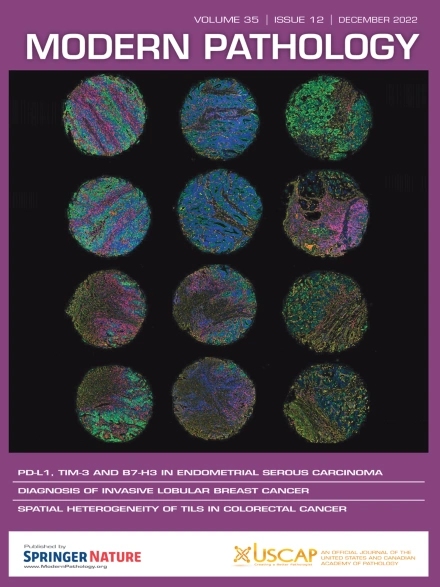Machine Learning Streamlines the Morphometric Characterization and Multiclass Segmentation of Nuclei in Different Follicular Thyroid Lesions: Everything in a NUTSHELL
IF 7.1
1区 医学
Q1 PATHOLOGY
引用次数: 0
Abstract
The diagnostic assessment of thyroid nodules is hampered by the persistence of uncertainty in borderline cases and further complicated by the inclusion of noninvasive follicular tumor with papillary-like nuclear features (NIFTP) as a less aggressive alternative to papillary thyroid carcinoma (PTC). In this setting, computational methods might facilitate the diagnostic process by unmasking key nuclear characteristics of NIFTP. The main aims of this work were to (1) identify morphometric features of NIFTP and PTC that are interpretable for the human eye and (2) develop a deep learning model for multiclass segmentation as a support tool to reduce diagnostic variability. Our findings confirmed that nuclei in NIFTP and PTC share multiple characteristics, setting them apart from hyperplastic nodules (HP). The morphometric analysis identified 15 features that can be translated into nuclear alterations readily understandable by pathologists, such as a remarkable internuclear homogeneity for HP in contrast to a major complexity in the chromatin texture of NIFTP and to the peculiar pattern of nuclear texture variability of PTC. A few NIFTP cases with available next-generation sequencing data were also analyzed to initially explore the impact of RAS-related mutations on nuclear morphometry. Finally, a pixel-based deep learning model was trained and tested on whole-slide images of NIFTP, PTC, and HP cases. The model, named NUTSHELL (NUclei from Thyroid tumors Segmentation to Highlight Encapsulated Low-malignant Lesions), successfully detected and classified the majority of nuclei in all whole-slide image tiles, showing comparable results with already well-established pathology nuclear scores. NUTSHELL provides an immediate overview of NIFTP areas and can be used to detect microfoci of PTC within extensive glandular samples or identify lymph node metastases. NUTSHELL can be run inside WSInfer with an easy rendering in QuPath, thus facilitating the democratization of digital pathology.
机器学习简化了不同甲状腺滤泡病变中细胞核的形态特征描述和多类分割:一切尽在简述。
对甲状腺结节的诊断评估因边界病例中持续存在的不确定性而受阻,并因具有乳头状核特征的非侵袭性滤泡性肿瘤(NIFTP)作为甲状腺乳头状癌(PTC)的一种侵袭性较低的替代物而进一步复杂化。在这种情况下,计算方法可以通过揭示 NIFTP 的关键核特征来促进诊断过程。这项工作的主要目的是:(1)识别人眼可解读的 NIFTP 和 PTC 形态特征;(2)开发一种用于多类分割的深度学习模型,作为减少诊断变异性的辅助工具。我们的研究结果证实,NIFTP 和 PTC 中的细胞核具有多种特征,使它们有别于增生性结节(HP)。形态计量分析确定了 15 个特征,这些特征可转化为病理学家易于理解的核改变,例如 HP 的核间同质性显著,而 NIFTP 的染色质纹理则非常复杂,PTC 的核纹理变异模式也很特别。此外,还分析了一些有 NGS 数据的 NIFTP 病例,以初步探索 RAS 相关突变对核形态学的影响。最后,在 NIFTP、PTC 和 HP 病例的整张切片图像(WSI)上训练和测试了基于像素的深度学习模型。该模型被命名为NUTSHELL(NUclei from Thyroid tumors Segmentation to Highlight Encapsulated Low-malignant Lesions),它成功地检测并分类了所有WSIs瓦片中的大多数细胞核,显示出与已经成熟的病理学核评分相当的结果。NUTSHELL 可提供 NIFTP 区域的即时概览,可用于检测大面积腺体样本中的 PTC 微小病灶或识别淋巴结转移。NUTSHELL可在WSInfer中运行,并可在QuPath中轻松渲染,从而促进数字病理学的民主化。
本文章由计算机程序翻译,如有差异,请以英文原文为准。
求助全文
约1分钟内获得全文
求助全文
来源期刊

Modern Pathology
医学-病理学
CiteScore
14.30
自引率
2.70%
发文量
174
审稿时长
18 days
期刊介绍:
Modern Pathology, an international journal under the ownership of The United States & Canadian Academy of Pathology (USCAP), serves as an authoritative platform for publishing top-tier clinical and translational research studies in pathology.
Original manuscripts are the primary focus of Modern Pathology, complemented by impactful editorials, reviews, and practice guidelines covering all facets of precision diagnostics in human pathology. The journal's scope includes advancements in molecular diagnostics and genomic classifications of diseases, breakthroughs in immune-oncology, computational science, applied bioinformatics, and digital pathology.
 求助内容:
求助内容: 应助结果提醒方式:
应助结果提醒方式:


